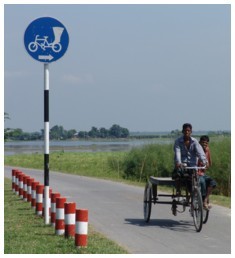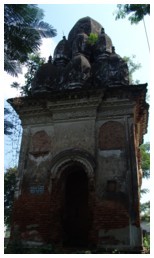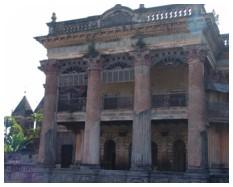|
The district
Rajshahi lies in the Western part of Bangladesh, on the Northern border of
the river Padma. This river forms part of the border with
India, and
standing on the elevated riverbank, you have a beautiful view over the
water towards this country, especially when the sun is setting. On the
Southern border of Rajshahi, the river moves land inwards and forms the
border between Rajshahi and Kulna. |
|
 The
road towards Rajshahi from
Dhaka
leads through beautiful rural area's, with "rickshaw paths" alongside the
road, which the people here call "lanes for slow transport" but in the
Netherlands they would simply be "bicycle paths". The
road towards Rajshahi from
Dhaka
leads through beautiful rural area's, with "rickshaw paths" alongside the
road, which the people here call "lanes for slow transport" but in the
Netherlands they would simply be "bicycle paths".
On the left and right side of the road we pass large lakes, sometimes full
of green plants. They are not very deep and become even more shallow in
the dry period of the year. People say they are not connected to the
river, that the only source of water is rain, but I have had no chance to
check the truth value of that statement. But beautiful they are, vast,
silent and shining, almost like frozen, with an occasional small boat.
There is little motorized traffic, so everywhere you see people with
bicycles with huge piles of hay struggling forward, and heavily loaded
cars, pulled by oxen. The people are skinny but very muscled and strong. |
|
 From
the 3rd century, Rajshahi was mainly Buddhist but from the 12th century,
more and more Hindus entered the country. The proof of this can be found
in the many Hindu temples that are left deserted in the city. From
the 3rd century, Rajshahi was mainly Buddhist but from the 12th century,
more and more Hindus entered the country. The proof of this can be found
in the many Hindu temples that are left deserted in the city.
A fter 1971, when Bangladesh became independent, many
Hindus moved to
India and Muslims were shifted
to Pakistan
and Bangladesh. There is still a high
concentration of Hindus in this area, though. fter 1971, when Bangladesh became independent, many
Hindus moved to
India and Muslims were shifted
to Pakistan
and Bangladesh. There is still a high
concentration of Hindus in this area, though.
In Rajshahi, there is also a rajbari, like in some other places in
Bangladesh. That is to say, you need a bit of imagination to be
able to recognize the grandeur, that once must have been there, because
what is left of it is a dark, stained, moldy pile of bricks which vaguely
reminds you of a palace.
In the 18th century, under
British influence, the country started
producing cotton and sugar; nowadays, the main agricultural products are
rice, mangoes and banana; the plantations are everywhere.
Rajshahi city is a university city and it has a pleasant student
atmosphere. Until late at night the shops are open, and students, girls as
well as boys, are outside shopping and talking.
Rajshahi is also a center of sericulture and from time to time, a
caterpillar may land on your stuff in the hotel room. The silk they
produce is beautiful, so thin that you can look straight through it. It is
machine made however, not hand woven and hand painted like the ikat silk
in
Ferghana
in
Uzbekistan, and painting is done outside the factory. |